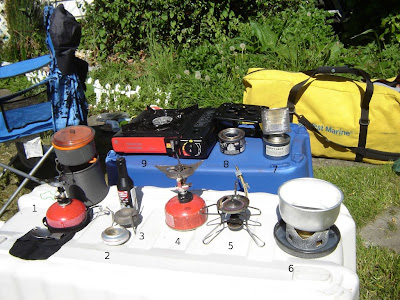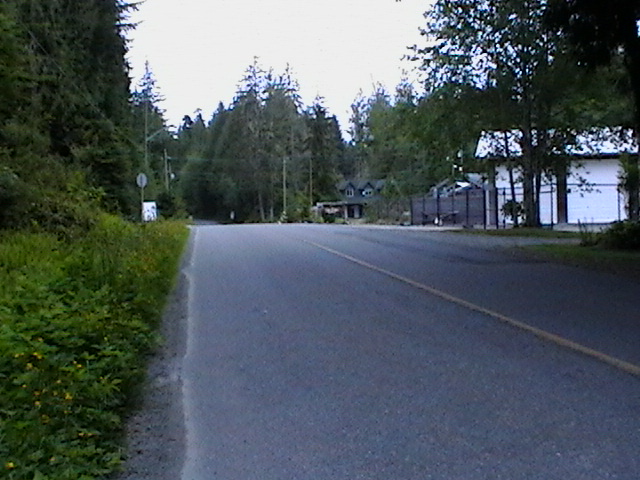The trip up was uneventful; the usual drinking tea and relaxing in big seats while the train rocked its way over the Malahat. As usual, the engineer stopped the train in the middle of each of the two trestles in order to let us all get a good look at the stunning views. The only excitement was provided by the three idiots walking across the second trestle as the train came upon them. But there are refuges provided and, thankfully, the three young men (I've a guy, and even I'm disappointed in these young men who seem to take the laws of self-preservation less seriously) were smart enough to actually get out of the way on the tracks.
The train pulled in to Ladysmith on time, and it took us only moments to hop off—even with the kayaks. We were a bit loaded down because Paula was leading a discussion on inflatable kayaks Saturday afternoon and so we were camping overnight in Transfer Beach Park, along with a couple of dozen other people. From the train stop to the beach was a fairly short walk (had we wished, it was a shorter walk across the highway to a motel we'd scouted out on a previous trip). The organizers allowed us some space to cache the kayaks until the discussion, and a little while later I had the tent set up. Before I could even tell Paula about it, she'd found it and changed into her paddling gear and was off to test out boats.
I'm still interested in boats, but more from a design standpoint these days. I ended up interviewing John Rogers from 8 Dragon Custom Kayaks (who builds beautiful wooden boats), and then cruising the gear sales and checking out new boat designs. Among the more interesting ones was Delta's new Catfish design: a catamaran hull sit-on-top. It looks like a well-thought-out fishing boat, and was one of the few boats I would ave been interested in trying out. Not because I'm looking for a catamaran hull sit-on-top, but just to see how well the design translates into function.
 The Catfish
The Catfish After renewing my acquaintance with Insomniac Coffee's coffee wagon, Marlene and I settled in for a bit of a mid-day nosh, and were joined by a couple who had earlier recognized John and Louise from the blog. We ended up having a great conversation and were slowly joined by the rest of the group, more food, and a couple of bags of fresh-made mini-doughnuts.
 Louise and Marlene talking to Mike Jackson
Louise and Marlene talking to Mike JacksonThe afternoon passed in usual Paddlefest style, with meeting new people, discussing boats and paddling, and generally spending a sunny afternoon with a couple of hundred un-met friends. John, Louise, and Marlene decided to leave about 3:00pm, but not before Louise won a double kayak rental from Sealegs Kayaking—which apparently means at least one more trip to Ladysmith this year. Paula hosted her discussion on inflatable kayaks which made up for its small attendance with brisk and wide-ranging conversation.
After the discussion, Paula and I packed up her boats and headed into Ladysmith to find dinner. We ended up at Robert's Street Pizza, where we were delighted with a very good pizza.
 Roberts St. Pizza
Roberts St. Pizza We had several choices of restaurant, but found ourselves wanting something simple and light instead of some of the more elaborate meals on offer. Although the Greek restaurant, Transfer Beach Grill, received a good review the next morning from the couple with whom we had breakfast.
Eventually we wandered back to Transfer Beach and, after chatting with other campers, we went to bed early and slept late.
The next morning was bright, and the night had been warm (much warmer than I'm used to experiencing when sleeping in a tent), and Paula came back to the tent chatting with a woman. We ended up at In The Bean Time with the other couple and had both a great breakfast (In The Bean Time would definitely become my second home if I lived in Ladysmith) and great company.
Almost regretfully, we four found our way back to the beach, where Paula inflated a kayak and took off for an extended paddle around the bay. I threw a few things into my new pack, and set off to break-in both boots and pack with a hike around Holland Creek.
The hiking trail extends from the marine trail that follows part of the bay, under the highway, and up through Ladysmith to one of the entrances to the Holland River trail.
The trail itself consists of three loops; the main loop, with one side being handicapped accessible and the other with some steep sections; the lower loop, which is fairly short and extends south from the Dogwood Road bridge (in itself a short and enjoyable hike); and the upper loop which is fairly difficult and takes you past Heart Lake (a lake advertised by the Ladysmith Chamber of Commerce on their website, as a “good place for skinny dipping”). Taken together, the three loops are about 14 or 15 kilometres long. The Marine Trail would add a few more kilometres to that.
I ended up hiking both the lower and main loop, although I ran out of time to make the upper loop. It was a great hike, And as the river is a salmon-spawning stream, there are warnings about bears in the fall, and the area is kept pretty pristine, making it a great hike. And right on the edge of Ladysmith —you could spend the night in a motel or B&B, spend the day hiking, have a swim, and spend the night indoors again, and have had a great time.
All in all, I'm very impressed with Ladysmith; from the support for keeping the historic buildings in downtown, to the free trolley making its rounds, to the beautiful park at the beach, the town has done several things correctly, making it a great place to visit. And the kid's playhouse I spotted in town was unbelievable.
Eventually, Paula and I met back up, packed up, and caught the E&N back to Victoria. We'd had a great weekend, and I'd had the chance to explore a bit more of the Island.
 Transfer Beach
Transfer Beach In The Bean Time
In The Bean Time
 Yes, its a playhouse
Yes, its a playhouse















